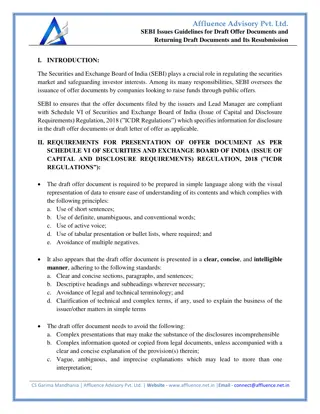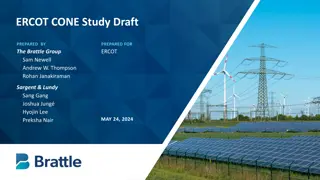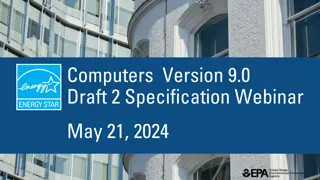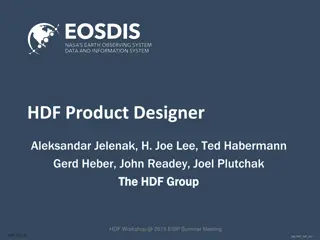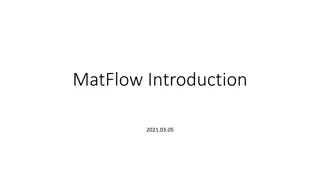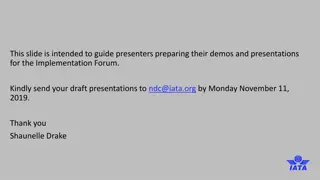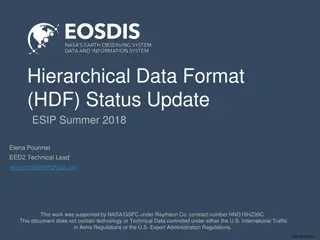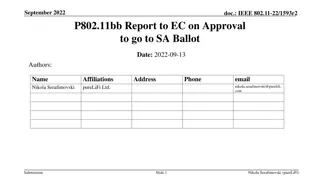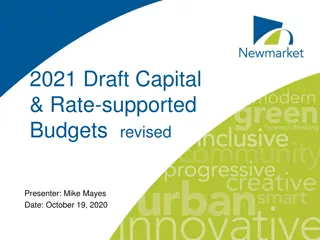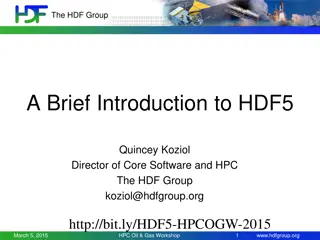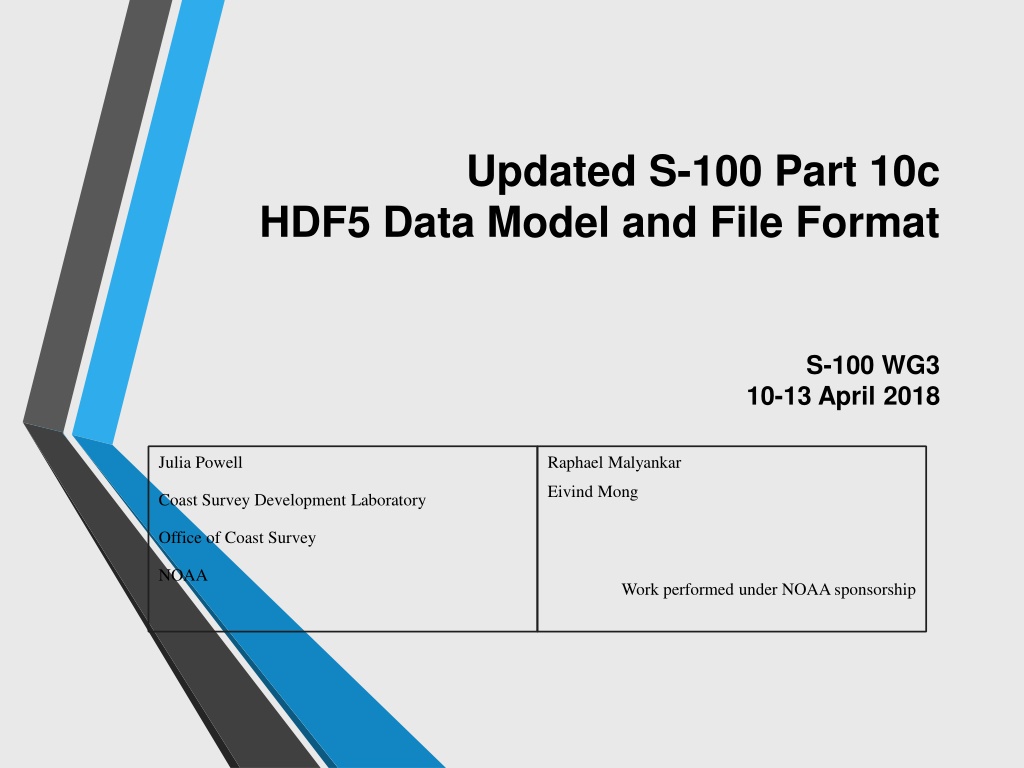
S-100 HDF5 Data Model: Requirements and Overview
"Explore the harmonization of spatial coverage formats, mapping between HDF5 and S-100 constructs, logical structures, and examples of feature information in the S-100 HDF5 data model. Learn about handling different coverage types, time series data, and linking HDF5 information to S-100 vector data."
Uploaded on | 0 Views
Download Presentation

Please find below an Image/Link to download the presentation.
The content on the website is provided AS IS for your information and personal use only. It may not be sold, licensed, or shared on other websites without obtaining consent from the author. Download presentation by click this link. If you encounter any issues during the download, it is possible that the publisher has removed the file from their server.
E N D
Presentation Transcript
Updated S-100 Part 10c HDF5 Data Model and File Format S-100 WG3 10-13 April 2018 Julia Powell Raphael Malyankar Eivind Mong Coast Survey Development Laboratory Office of Coast Survey NOAA Work performed under NOAA sponsorship
Requirements Harmonize formats for coverage spatial types Several are currently under development S-111, S-102, S-104 S-100 3.0.0 has general notions for imagery and gridded data but leaves details to product specification authors. An ECDIS application should be able to read any data product that claims conformance to Part 10c, without requiring the implementation of product- specific software modules. Handle the different types of coverages listed in S-100 8-6.2.2: Multipoints, rectangular and irregularly shaped grids, variable cell sizes, TIN Grids in 2 or 3 dimensions Simple and tiled grids Handle time series and moving platform information Clear mapping between data format and S-100 feature catalogues Links between HDF5 information and S-100 vector information
Overview of extensions to Part 10c Specification of mapping between HDF5 and S-100 constructs Extracts from XML feature catalogues are encoded in a specific HDF5 object (Feature Information Group Group_F ). The extracts provide enough information to process the HDF5 file standalone. Features and attributes in S-100 feature catalogues are linked to objects in the HDF5 file via use of the code (camel-case name) defined in the feature catalogue. Selected metadata elements defined in S-100 are encoded in the HDF5 file. Specification of logical layouts for spatial information (coverage geometry) and data values Rules for naming data objects for features, attributes, and spatial coordinates Rules defining the data structures for spatial information and data values information Rules for structuring the HDF file and the objects it contains Provision for referencing feature and information types defined in GML and ISO 8211 files Requirements, guidelines & hints for product specification authors and implementers
Basic logical structure Dataset Metadata Container for all instances of a feature type + metadata common to all the feature instances Single feature instance + instance- specific metadata Data values (thematic attribute values) (> 1 group for time series data) Type spec. for features and attributes (= S-100 FC + HDF5 extras) Tiles Feature geometry coordinates Spatial indexes S-100 dataset Physical HDF5 file
Example of Feature Container and Feature Instance groups 6
Storage of coordinates and data values Coverage type Regular grid Coordinate values Not explicitly stored Computable from metadata Not explicitly stored Computable from metadata Data values D-dimensional array of value tuples 1-d array of value tuples + information about location of cells 1-d array of value tuples + information about cell size and location Irregular grid Variable cell size grid Not explicitly stored Computable from metadata Fixed stations, ungeorectified grid, moving platform TIN 1-d array of coordinate tuples 1-d array of value tuples 1-d array of coordinate tuples + triangle information 1-d array of value tuples The datasets storing coordinates and values are designed so as to use uniform data storage structures across different coverage types as well as reduce the total data volume. 7
Metadata principles The Exchange Catalogue and ISO metadata files are the same as for other formats Metadata is of two types: (i) `ordinary metadata e.g., S- 100 discovery metadata, and (ii) grid parameters Metadata is attached to levels appropriate to the subset of objects it covers. Metadata attached to the root group applies to the whole file (e.g., issue date) Metadata attached to feature containers applies to all features inside that container (nominally, all features of the same feature type). E.g., dimension. Metadata attached to a feature instance group applies only to that feature instance. E.g., the bounding box of the grid. 8
Detailed logical structure
Other additions Some guidance for product specification developers on how to define the HDF5 data format for a product using this profile. Guidance on extensions: Product specifications may extend the format by defining new data structures, but all extensions must be such that implementations can ingest and portray data without processing the additional data structures. Product-specific metadata can be added, but should not have any effects on processing or portrayal (i.e., display-only). Things that affect portrayal or processing should be submitted as an S-100 update proposal. Draft contains some development guidance for implementers. 10
Open questions and judgement calls Harmonization with Climate Forecast (CF) conventions is TBD. Lower-level group structure: Retain separation into tiling, index, geometry, and value groups? Place the tiles, index, geometry, and value as different HDF5 datasets in the same group? Place all time series data in the same group instead of Group_NNNs? Combine coordinate and data values into one dataset? Combining means some uniformity will be lost, since the record type will depend on the type of coverage. Encoding of polygons referenced by features (e.g., influence polygons, meta-features such as DataCoverage): Retain current approach reference a GML or ISO 8211 dataset Develop a data structure to encode polygons as vector objects inside the HDF5 file (including exterior and interior rings). Encode polygons as blobs based on another format e.g., encode the GML GM_Surface object verbatim (using only inline coordinates).
Open questions - 2 Add scale offset encoding for both data values and coordinates, for more compact storage? Allow storage of coordinates as integers instead of floating point values using the coordinate multiplication factor technique? For uniformity, store data values for regular grids as 1-D compound array, like the other formats?
Recommendations Consider encoding time series using the T dimension instead of separate datasets or groups (e.g., 3-D time series data values are stored as XYZT arrays).
Next steps Some changes may still happen based on feedback Testing is required The teams that are currently looking to use HDF5 are involved in the feedback and review Agree in principle to the concepts that are being added and then work everything out via correspondence in the next couple of months.



